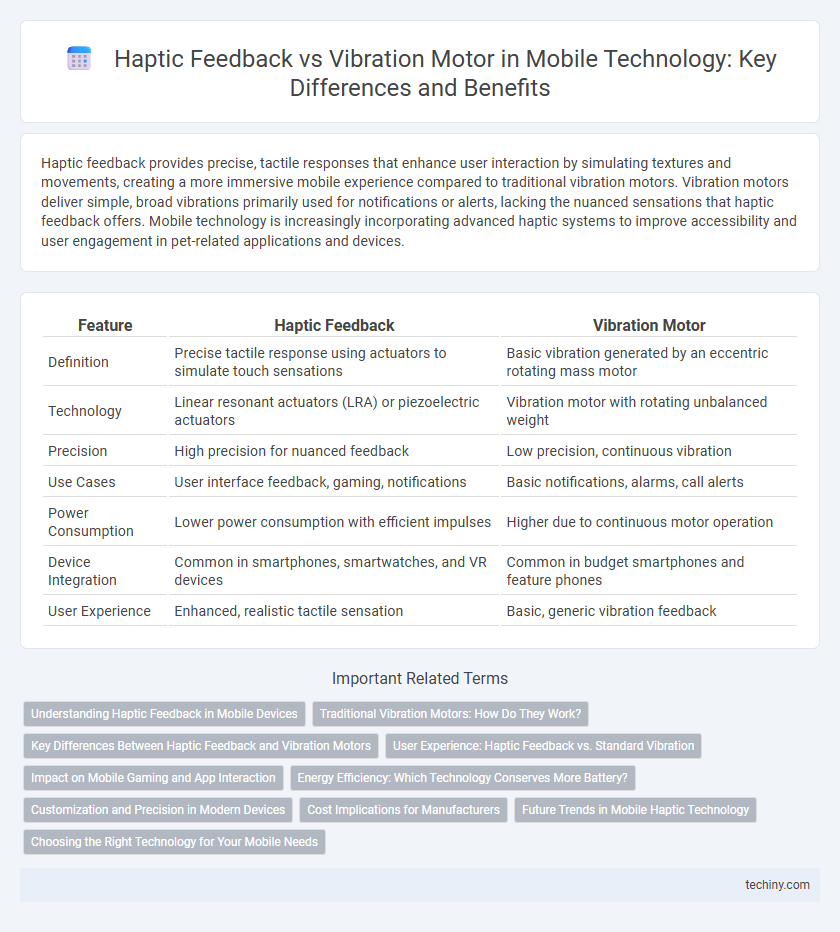Haptic feedback provides precise, tactile responses that enhance user interaction by simulating textures and movements, creating a more immersive mobile experience compared to traditional vibration motors. Vibration motors deliver simple, broad vibrations primarily used for notifications or alerts, lacking the nuanced sensations that haptic feedback offers. Mobile technology is increasingly incorporating advanced haptic systems to improve accessibility and user engagement in pet-related applications and devices.
Table of Comparison
| Feature | Haptic Feedback | Vibration Motor |
|---|---|---|
| Definition | Precise tactile response using actuators to simulate touch sensations | Basic vibration generated by an eccentric rotating mass motor |
| Technology | Linear resonant actuators (LRA) or piezoelectric actuators | Vibration motor with rotating unbalanced weight |
| Precision | High precision for nuanced feedback | Low precision, continuous vibration |
| Use Cases | User interface feedback, gaming, notifications | Basic notifications, alarms, call alerts |
| Power Consumption | Lower power consumption with efficient impulses | Higher due to continuous motor operation |
| Device Integration | Common in smartphones, smartwatches, and VR devices | Common in budget smartphones and feature phones |
| User Experience | Enhanced, realistic tactile sensation | Basic, generic vibration feedback |
Understanding Haptic Feedback in Mobile Devices
Haptic feedback in mobile devices provides nuanced tactile sensations through advanced actuators that simulate textures and pressure, enhancing user interaction beyond basic vibration alerts. Unlike traditional vibration motors that produce simple, uniform buzzing, haptic technology uses precision control to deliver varied patterns and intensities, improving the realism and immersion of touch experiences. This sophisticated feedback mechanism supports functionalities such as gaming, virtual keyboards, and augmented reality applications by offering intuitive, tactile responses.
Traditional Vibration Motors: How Do They Work?
Traditional vibration motors operate by using an unbalanced mass attached to a rotating shaft, which generates centrifugal force to produce vibrations when the motor spins. These motors are commonly used in mobile devices to provide basic tactile feedback by converting electrical energy into mechanical oscillations. Although simple and cost-effective, vibration motors deliver uniform vibrations lacking the precise, varied sensations found in advanced haptic feedback systems.
Key Differences Between Haptic Feedback and Vibration Motors
Haptic feedback uses advanced actuators like piezoelectric or linear resonant actuators to deliver precise, textured sensations, whereas vibration motors rely on simple eccentric rotating mass (ERM) mechanisms producing uniform vibrations. Haptic feedback enables nuanced interactions such as simulating textures or button clicks, while vibration motors typically provide basic alerts and notifications. The superior control and responsiveness of haptic feedback enhance user experience by offering more immersive and context-sensitive tactile responses compared to conventional vibration motors.
User Experience: Haptic Feedback vs. Standard Vibration
Haptic feedback enhances user experience by providing precise, varied tactile sensations that simulate real-world touch interactions, unlike standard vibration motors that deliver uniform, less nuanced pulses. This advanced technology improves device usability in smartphones, gaming controllers, and wearables by conveying more detailed information through nuanced vibrations. Users benefit from increased immersion and intuitive feedback, making interactions more engaging and responsive.
Impact on Mobile Gaming and App Interaction
Haptic feedback enhances mobile gaming and app interaction by providing precise, nuanced tactile sensations through advanced actuators, improving user immersion and control accuracy compared to traditional vibration motors. Vibration motors generate broad, less detailed vibrations primarily for notifications, which may lack the fine-grained feedback needed for complex gaming or app tasks. Implementing haptic feedback technology allows developers to create more engaging and responsive experiences, driving greater user satisfaction and retention in mobile applications.
Energy Efficiency: Which Technology Conserves More Battery?
Haptic feedback utilizes precise, localized actuators that consume less power by activating only when necessary, whereas vibration motors often run continuously at higher energy levels to produce broader vibrations. Studies show haptic feedback systems can extend battery life by up to 30% compared to traditional vibration motors due to targeted energy use. Optimizing mobile devices with haptic feedback enhances user experience while conserving battery capacity more effectively.
Customization and Precision in Modern Devices
Haptic feedback in modern mobile devices offers advanced customization and precision by using actuators that simulate textures and nuanced touch sensations, enhancing user interaction beyond the basic on/off signals of traditional vibration motors. Vibration motors provide general alerts with limited intensity control and uniform oscillation patterns, whereas haptic engines enable developers to fine-tune feedback parameters such as amplitude, frequency, and duration. This precise control improves user experiences in gaming, accessibility features, and immersive applications by delivering tailored tactile responses unique to each interaction.
Cost Implications for Manufacturers
Haptic feedback systems, which use precise actuators like linear resonant actuators (LRAs) or piezoelectric motors, generally incur higher manufacturing costs compared to traditional vibration motors due to advanced component requirements and complex integration. Vibration motors, typically coin or eccentric rotating mass (ERM) types, are more cost-effective and simpler to implement but offer less nuanced tactile responses. Manufacturers must balance the enhanced user experience of haptic feedback against the increased production expenses and potential impact on device pricing.
Future Trends in Mobile Haptic Technology
Future trends in mobile haptic technology emphasize advanced haptic feedback systems that deliver precise, nuanced tactile sensations beyond traditional vibration motors. Innovations in electrostatic and piezoelectric haptics enable immersive touch experiences, enhancing user interaction with smartphones, wearables, and AR/VR devices. Integration of AI-driven adaptive haptics will personalize feedback patterns, improving accessibility and engagement in mobile applications.
Choosing the Right Technology for Your Mobile Needs
Haptic feedback provides precise tactile responses through advanced actuators generating varied sensations, enhancing user experience in smartphones and gaming devices. Vibration motors offer simpler, cost-effective alerts by delivering consistent vibrations, suitable for basic notifications and calls. Selecting the right technology depends on the desired level of interaction, device cost, and application purpose, with haptic feedback ideal for immersive experiences and vibration motors for straightforward alerts.
Haptic Feedback vs Vibration Motor Infographic

 techiny.com
techiny.com